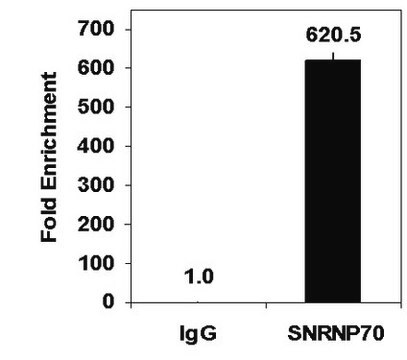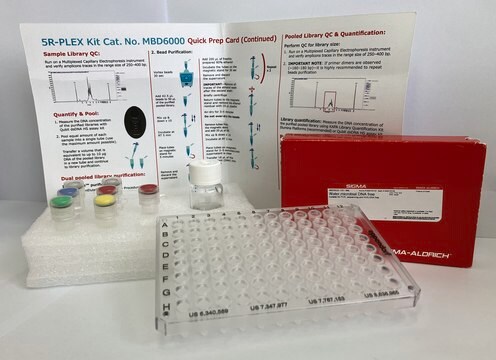17-10521
EZ-Magna NuCLEAR™ RIP (Cross-Linked) Nuclear RNA-Binding Protein Immunoprecipitation Kit
EZ-Magna Nuclear RIP (Cross-Linked) RNA-Binding Protein Immunoprecipitation Kit is designed for the analysis of chromatin associated RNA such lncRNAs, enhancer RNAs and miRNAs.
Synonim(y):
Magnetic RNA-BP Immunoprecipitation, RNA-Binding Protein Immunoprecipitation
About This Item
Polecane produkty
Poziom jakości
producent / nazwa handlowa
Magna Nuclear RIP
metody
RIP: suitable
activity assay: suitable (protein interaction)
immunoprecipitation (IP): suitable
Warunki transportu
dry ice
Powiązane kategorie
Opis ogólny
- Generates cross-linked chromatin to allow analysis of a variety of chromatin-associated RNAs
- Flexible, scalable input requirements: Recover RNA from millions of cells or as few as 5,000 cells
- Magnetic protein A/G bead blend and optimized buffer system results in low backgrounds and high signal-to-noise ratios
- Suitable for analysis by RT-qPCR or RIP-seq
- Complete set of reagents and detailed protocol to enable first-time success
Magna Nuclear RIP Kits are specially designed to allow the discovery and analysis of a variety of chromatin associated RNAs such as long non-coding RNAs, enhancer RNAs and miRNAs . These chromatin-associated RNAs often regulate gene expression and can be analyzed with applications including quantitative reverse transcription polymerase chain reaction (RT-PCR), microarray analysis (RIP-chip) and next generation sequencing (RIP-Seq).
Nuclear RIP can be performed using chromatin that has interactions stabilized by formaldehyde treatment (cross-linked) or chromatin that has not been treated with a cross linking reagent (native). While both of these approaches are similar in that they are designed to recover chromatin associated RNA, the reagents used and the details of the protocol and types of interactions typically detected are different. Cross-linked can capture higher molecular weight complexes in in vivo configurations with possibly lower affinities. In contrast native RIP is expected to recover high affinity, more direct interactions between proteins encoded RNA binding motifs and candidate RNAs. For less well understood proteins and protein complexes often both approaches are used.
The kit described here is for the cross-linked approach. If a native approach is of interest please visit the product page for the Magna Nuclear RIP (Native) Kit, catalogue # 17-10522 or the EZ-Magna Nuclear RIP (Native) Kit, catalogue # 17-10523.
Opakowanie
Komponenty
10X PBS
Nuclei Isolation Buffer
RIP Cross-Linked Lysis Buffer
Protein A/G Magnetic Beads
Nuclear RIP Dilution Buffer
Low Salt Wash Buffer
High Salt Wash Buffer
LiCl Wash Buffer
TE Buffer
RIP Elution Buffer
10% SDS
0.5 M EDTA
DNase I (RNase Free)
DNase I Supplement
DNase I Reaction Buffer
Protease Inhibitor Cocktail III, Animal Free
RNAse Inhibitor
Proteinase K
Control Antibodies and Primers
Normal Mouse IgG Negative Control Antibody
Anti-EZH2 Positive Control Antibody
NEAT1 Positive Control Primers
U1 snRNA Negative Control Primers
Postać fizyczna
Przechowywanie i stabilność
Kit components are stable for 6 months from date of shipment when stored as directed.
Informacje prawne
Hasło ostrzegawcze
Danger
Zwroty wskazujące rodzaj zagrożenia
Zwroty wskazujące środki ostrożności
Klasyfikacja zagrożeń
Aquatic Acute 1 - Aquatic Chronic 2 - Eye Dam. 1 - Skin Irrit. 2
Kod klasy składowania
10-13 - German Storage Class 10 to 13
Klasa zagrożenia wodnego (WGK)
WGK 3
Certyfikaty analizy (CoA)
Poszukaj Certyfikaty analizy (CoA), wpisując numer partii/serii produktów. Numery serii i partii można znaleźć na etykiecie produktu po słowach „seria” lub „partia”.
Masz już ten produkt?
Dokumenty związane z niedawno zakupionymi produktami zostały zamieszczone w Bibliotece dokumentów.
Nasz zespół naukowców ma doświadczenie we wszystkich obszarach badań, w tym w naukach przyrodniczych, materiałoznawstwie, syntezie chemicznej, chromatografii, analityce i wielu innych dziedzinach.
Skontaktuj się z zespołem ds. pomocy technicznej








